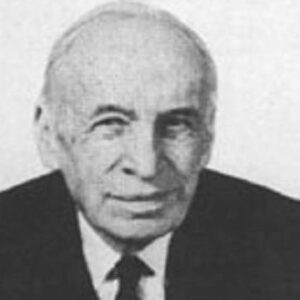American physicist and mathematician John Hasbrouck Van Vleck was awarded a portion of the 1977 Nobel Prize in Physics for his contributions to the understanding of the behavior of electrons in magnetic materials. He produced the first completely articulated quantum mechanical theory of magnetism during the 1930s. In addition to his substantial contributions to the study of magnetism, he also made important contributions to the research of the spectra of free molecules, of paramagnetic relaxation, and of other issues. As the son of mathematician Edward Burr Van Vleck and grandson of astronomer John Monroe Van Vleck, he was encouraged from a young age to pursue scientific inquiries. As a youth, he attended the University of Wisconsin at Madison and Harvard University, where he earned his doctorate. He pursued a career in academia and taught at a number of universities before returning to Harvard, where he finally became the head of the physics department. His significant contributions to the quantum mechanical theory of magnetism and crystal field theory earned him the title “Father of Modern Magnetism.”
Youth and Early Life
John Hasbrouck Van Vleck was born on March 13, 1899, in Middletown, Connecticut, to mathematician Edward Burr Van Vleck and his wife, Hester Laurence Raymond. His grandpa was John Monroe Van Vleck, an astronomer.
Growing raised in an intellectually stimulating environment, he showed early aptitude in science and mathematics. In 1920, he received an A.B. from the University of Wisconsin–Madison.
Then, in 1922, he attended Harvard University for graduate study and got a Ph.D. His doctoral dissertation was on the calculation of the binding energy of a particular model of the helium atom, which he completed under the supervision of Professor Kemble, the only person in the United States at the time who was qualified to direct purely theoretical research in quantum atomic physics.
John Vleck’s Career
In 1923, John Hasbrouck Van Vleck was given a position as an assistant professor at the University of Minnesota, where he would teach only graduate-level courses. The opportunity afforded the young scientist sufficient time to devote to research, to his joy.
In 1924, Van Vleck developed his correspondence approach for absorption. He established that, in the limit of large quantum numbers, there would be a correspondence between the absorption by classical, multiple periodic systems and by their quantum analogs. This was a noteworthy discovery for the time period.
During his time at the University of Minnesota, he wrote a paper for the National Research Council titled “Quantum Principles and Line Spectra.” It was an instantaneous success upon publishing, swiftly selling out its initial printing of 1,000 copies, and in 1928, a further 300 copies were printed.
He held the position of professor at the University of Wisconsin from 1928 to 1934. In 1932, he released his second book, The Theory of Electric and Magnetic Susceptibilities, which he began writing at this time. He also published his first study on crystal field theory in the same year.
He came to Harvard University in the 1930s and remained there until his retirement in 1969. Throughout his tenure at the university, he held a variety of posts, including chairman of the physics department (1945–49), dean of engineering and applied physics (1951–57), and Hollis professor of mathematics and natural philosophy (1951–69).
Throughout his career, he established the principles of the quantum mechanical theory of magnetism and the crystal field theory (chemical bonding in metal complexes). As a result, he is considered the Father of Modern Magnetism.
During World War II, he participated in the Manhattan Project and was a member of the scientific group that evaluated and created the atomic bomb’s design concepts.
In addition to his teaching obligations at Harvard, he contributed to the war effort by working on radar at the MIT Radiation Laboratory. His study in this area was crucial not only for the development of military and civilian radar systems but also for the creation of the new science of radioastronomy.
His Notable Works
William Hasbrouck During World War II, Van Vleck participated in the Manhattan Project, a research and development effort that created the first nuclear weapons. Van Vleck, along with other eminent theoretical physicists, investigated and established the fundamentals of atomic weapon design.
During World War II, he worked on radar and established that at around 1.25-centimeter wavelength, water molecules in the atmosphere would cause problematic absorption, and at 0.5-centimeter wavelength, oxygen molecules would have a similar effect.
Honors & Accomplishments
In 1965, he received the Irving Langmuir Award, and in 1966, the National Medal of Science, the Elliott Cresson Medal, and in 1974, the Lorentz Medal.
1977 Nobel Prize in Physics was awarded jointly to John Hasbrouck van Vleck, Philip Warren Anderson, and Sir Nevill Francis Mott “for their basic theoretical discoveries into the electrical structure of magnetic and disordered systems.”
Personal History and Legacy
In 1927, he married Abigail Pearson. They were both significant art collectors, notably of Japanese woodblock prints (principally Ukiyo-e). Their union lasted more than half a century.
On October 27, 1980, at the age of 81, he passed away.
Estimated Net worth
2019 Net Worth Estimate: $100K to $1M (Approx.)


